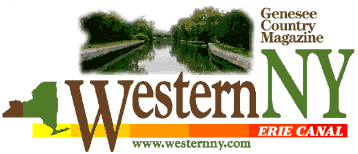|
|
|
|
©2008,
| |
| Clarion
Publications, Inc. All rights reserved | |
A Erie Glossary: Or how to talk like a "canawler"
Aqueduct: a structure that carries a canal across another body of water. Basin: a wider, deeper section of the canal, where boats can be moored and cargo loaded or unloaded. Berm, heelpath: the side opposite the towpath. Canawl (canawler): pronounciation of canal; (those who worked on it.) Dutch or Irish derivation. Durham: a big, clumsy, flat-bottomed boat used by early settlers. Not a Packet: a sleek passenger boat. Fog-gang: workers who cleaned out the canal as an annual routine. Foofoos: immigrant workers; foreigners. Grog: a tankard of ale; rhymes with Prog: food. Hoggee: a mule driver who was paid pitifully low wages. Hoodledasher: a hook-up of two or more empty boats tied to a full-cargo boat, pulled by one team of mules. Jigger-boss: a boy given the task of doling out half-gills of whiskey to each workman 16 times a day. "Low bridge": The warning cry to hit the deck because the canal boat was about to pass under a bridge. Bridges were built low to save money. Mule: the sterile offspring of a male donkey and a female horse; sometimes called a long-eared robin by canawlers or a hayburner . Mudlarked: a boat grounded due to insufficient water level, frequently from a leak or break out. Prism: the traditional shape of the canal ditch with a narrow bottom and angled sides. Rhino: ready money, cash; a person with a great deal of ready money was rhino fat. Runners & scalpers: Agents, often young boys, hired to secure passengers or cargo. Shipshape macaroni: a sportily attired canal boat captain. Trippers: long-haul workmen who traveled back and forth between Albany and Buffalo.
Adapted from "Low Bridge! Folklore and the Erie Canal" by Lionel Wyld. Syracuse University Press, 1962 |
According to WebCounter you are the
person to seek the Best of the West!
|
